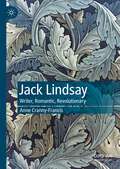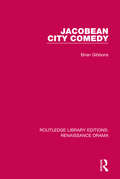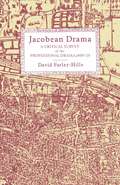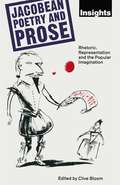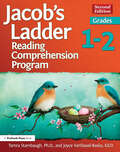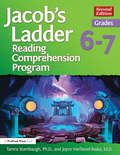- Table View
- List View
J. W. H. Atkins on Literary Criticism
by J. W. AtkinsOriginally published between 1934 and 1952 these volumes are classics in the field of literary criticism. Their author was a respected scholar whose ability to survey a vast field of literature and criticism and explain and un-tangle it to students was well-known. The volumes: Analyze styles of literary criticism prevalent in ancient Greece and after the rise of the Roman EmpireIllustrates the first phases of the growth of a tradition of criticismReview the critical achievement at the RenaissanceDiscuss the theories and judgments of various critics and their bearing on literary appreciation between the Renaissance and the dawn of 19th Century Romanticism.
Jaakko Hintikka on Knowledge and Game-Theoretical Semantics (Outstanding Contributions to Logic #12)
by Hans Van Ditmarsch Gabriel SanduThis book focuses on the game-theoretical semantics and epistemic logic of Jaakko Hintikka. Hintikka was a prodigious and esteemed philosopher and logician, and his death in August 2015 was a huge loss to the philosophical community. This book, whose chapters have been in preparation for several years, is dedicated to the work of Jaako Hintikka, and to his memory.This edited volume consists of 23 contributions from leading logicians and philosophers, who discuss themes that span across the entire range of Hintikka’s career. Semantic Representationalism, Logical Dialogues, Knowledge and Epistemic logic are among some of the topics covered in this book's chapters.The book should appeal to students, scholars and teachers who wish to explore the philosophy of Jaako Hintikka.
Jack Absolute Flies Again (Modern Plays)
by Richard Bean Oliver ChrisWhat will happen in England after we have won this war?Bunting! Bunting everywhere!After the bunting has been taken down.They will never take down our bunting!July 1940. After an aerial dog fight, Pilot Officer Jack Absolute flies home to win the heart of his old flame, Lydia Languish.Back on British soil, Jack's advances soon turn to anarchy when the young heiress demands to be loved on her own, very particular, terms.Richard Brinsley Sheridan's classic comedy of manners, The Rivals, is given an uproarious Battle of Britain update by Richard Bean and Oliver Chris.In 2011, Richard Bean became the first playwright to win the Evening Standard Award for Best Play for two plays, The Heretic and One Man, Two Guvnors. This edition was published to coincide with the world premiere at the National Theatre, London, in July 2022.
Jack Absolute Flies Again (Modern Plays)
by Richard Bean Oliver ChrisWhat will happen in England after we have won this war?Bunting! Bunting everywhere!After the bunting has been taken down.They will never take down our bunting!July 1940. After an aerial dog fight, Pilot Officer Jack Absolute flies home to win the heart of his old flame, Lydia Languish.Back on British soil, Jack's advances soon turn to anarchy when the young heiress demands to be loved on her own, very particular, terms.Richard Brinsley Sheridan's classic comedy of manners, The Rivals, is given an uproarious Battle of Britain update by Richard Bean and Oliver Chris.In 2011, Richard Bean became the first playwright to win the Evening Standard Award for Best Play for two plays, The Heretic and One Man, Two Guvnors. This edition was published to coincide with the world premiere at the National Theatre, London, in July 2022.
Jack Katz: Untersuchungen zur emotionalen Metamorphose des Selbst (Wissen, Kommunikation und Gesellschaft)
by Hubert KnoblauchEmotionen lassen sich nicht auf innerpsychische Vorgänge reduzieren, sie finden auch nicht im Hirn statt, Emotionen haben vor allem mit dem Verhältnis der Menschen zueinander zu tun. In seiner faszinierenden Studie über die „ausrastenden Autofahrer“ und über das Weinen bietet Katz mittlerweile klassisch gewordene Analysen der Emotionen, die hier erstmals in deutscher Sprache vorliegen. Katz zeigt darin etwa, wie Emotionen mit kleinen narrativen Projekten verbunden sind, mit denen wir ihnen einen Sinn verleihen. Daneben sind die Interaktionsprozesse zentral, in denen Emotionen auftreten, denn sie tragen dazu bei, wie unser Körper die Emotionen ausdrückt. Schließlich führen die Emotionen zu einer Metamorphose der körperlichen Sinnlichkeit. Indem eine Person sich ins Lachen, Weinen oder Ärgern hinein und wieder hinaus begibt, ändert sich der sinnliche Rahmen ihres Handelns. Diese Veränderungen betreffen den ausführenden Körper.
Jack Kerouac and the Literary Imagination
by N. GraceAn exploration of Kerouac's fiction, poetry, religious writing, journals, and correspondence. It encompasses his fictional rewriting of his personal life, his life-long quest for spiritual enlightenment, and his resolute belief in the blending of popular and academic cultural artifacts to create voices and forms to speak of and to a new age.
Jack Lindsay: Writer, Romantic, Revolutionary
by Anne Cranny-FrancisThis book offers an in-depth analysis of the work of prolific writer, activist and publisher, Jack Lindsay (1900-1990). It maps the development of his ideas across the twentieth century by reference to the five British writers about whom he published major studies: William Blake, John Bunyan, Charles Dickens, George Meredith and William Morris. At the same time it maps the formation through the twentieth-century of Left cultural politics, which Lindsay repeatedly anticipated in areas such as the fundamental interconnectedness of human beings and the natural world, the formative role of culture in both social and individual being, the crucial role of the senses in embodied being and the rejection of mind/body dualism. Through his analysis Lindsay foretold both the social alienation and the environmental degradation that characterise the beginning of the twenty-first century, while his interdisciplinary research and transdisciplinary analysis provide models for how we might address these critical concerns.
Jack the Ripper in Film and Culture: Top Hat, Gladstone Bag and Fog (Crime Files)
by Clare SmithIn 1888 the name Jack the Ripper entered public consciousness with the brutal murders of women in the East End of London. The murderer was never caught, yet film and television depicts a killer with a recognisable costume, motive and persona. This book examines the origins of the screen presentation of the four key elements associated with the murders – Jack the Ripper, the victims, the detective and Whitechapel. Nineteenth-century history, art and literature, psychoanalytical theories of Freud and Jung and feminist film theory are all used to deconstruct the representation of Jack the Ripper on screen.
Jacobean City Comedy (Routledge Library Editions: Renaissance Drama)
by Brian GibbonsThe first decade of the Jacobean age witnessed a sudden profusion of comedies satirizing city life; among these were comedies by Ben Jonson, John Marston and Thomas Middleton, as well as the bulk of the repertory of the newly-established children’s companies at Blackfriars and Paul’s. The playwrights self-consciously forged a new genre which attracted London audiences with its images of folly and vice in Court and City, and hack-writing dramatists were prompt to cash in on a new theatrical fashion. This study, first published in 1980, examines ways in which the Jacobean city comedy reflect on the self-consciousness of audiences and the concern of the dramatists with Jacobean society. This title will be of interest of students of Renaissance Drama, English Literature and Performance.
Jacobean City Comedy (Routledge Library Editions: Renaissance Drama)
by Brian GibbonsThe first decade of the Jacobean age witnessed a sudden profusion of comedies satirizing city life; among these were comedies by Ben Jonson, John Marston and Thomas Middleton, as well as the bulk of the repertory of the newly-established children’s companies at Blackfriars and Paul’s. The playwrights self-consciously forged a new genre which attracted London audiences with its images of folly and vice in Court and City, and hack-writing dramatists were prompt to cash in on a new theatrical fashion. This study, first published in 1980, examines ways in which the Jacobean city comedy reflect on the self-consciousness of audiences and the concern of the dramatists with Jacobean society. This title will be of interest of students of Renaissance Drama, English Literature and Performance.
Jacobean Drama: A Critical Survey of the Professional Drama, 1600-1625
by David Farley-HillsJonson, Marston, Chapman, Middleton, Heywood, Webster and Fletcher are playwrights of the Jacobean stage whose outstanding literary achievements have to some extent been obscured or misunderstood in Shakespeare's shadow. This timely reassessment, based on the accumulated scholarship of the decades since Una Ellis-Fermor's Jacobean Drama in 1936, comes when the opening of the Swan Theatre at Stratford-upon-Avon gives the public, at last, the chance to see on the professional stage some of the neglected masterpieces of the richest period of our theatre.
Jacobean Dramatists: Critical Heritage Set
by B. C. SouthamComprises of individual volumes on: Christopher Marlowe, Ben Jonson and John Webster.The Critical Heritage gathers together a large body of critical sources on major figures in literature. Each volume presents contemporary responses to a writer's work, enabling students and researchers to read for themselves, for example, comments on early performances of Shakespeare's plays, or reactions to the first publication of Jane Austen's novels.The carefully selected sources range from landmark essays in the history of criticism to journalism and contemporary opinion, and little published documentary material such as letters and diaries. Significant pieces of criticism from later periods are also included, in order to demonstrate the fluctuations in an author's reputation.Each volume contains an introduction to the writer's published works, a selected bibliography, and an index of works, authors and subjects.The Collected Critical Heritage set will be available as a set of 68 volumes and the series will also be available in mini sets selected by period (in slipcase oxes) and as individual volumes.
Jacobean Dramatists: Critical Heritage Set
by B. C. SouthamComprises of individual volumes on: Christopher Marlowe, Ben Jonson and John Webster.The Critical Heritage gathers together a large body of critical sources on major figures in literature. Each volume presents contemporary responses to a writer's work, enabling students and researchers to read for themselves, for example, comments on early performances of Shakespeare's plays, or reactions to the first publication of Jane Austen's novels.The carefully selected sources range from landmark essays in the history of criticism to journalism and contemporary opinion, and little published documentary material such as letters and diaries. Significant pieces of criticism from later periods are also included, in order to demonstrate the fluctuations in an author's reputation.Each volume contains an introduction to the writer's published works, a selected bibliography, and an index of works, authors and subjects.The Collected Critical Heritage set will be available as a set of 68 volumes and the series will also be available in mini sets selected by period (in slipcase oxes) and as individual volumes.
Jacobean Poetry And Prose: Rhetoric Representation And The Popular Imagination (Insights Ser.)
by Clive BloomJacobean Private Theatre (Routledge Library Editions: Renaissance Drama)
by Keith SturgessIn this scholarly and entertaining book, first published in 1987, the author tells the story of Jacobean private theatre. Most of the best plays written after 1610, including Shakespeare’s late plays such as The Tempest, were written for the new breed of private playhouses – small, roofed and designed for an aristocratic, literary audience, as opposed to the larger, open-air houses such as the Globe and the Red Bull, catering for a popular, ‘lowbrow’ audience. The author discusses the polarisation of taste and the effect it had on literary criticism and theatre history. This title will be of interest to students of English Literature, Drama and Performance.
Jacobean Private Theatre (Routledge Library Editions: Renaissance Drama)
by Keith SturgessIn this scholarly and entertaining book, first published in 1987, the author tells the story of Jacobean private theatre. Most of the best plays written after 1610, including Shakespeare’s late plays such as The Tempest, were written for the new breed of private playhouses – small, roofed and designed for an aristocratic, literary audience, as opposed to the larger, open-air houses such as the Globe and the Red Bull, catering for a popular, ‘lowbrow’ audience. The author discusses the polarisation of taste and the effect it had on literary criticism and theatre history. This title will be of interest to students of English Literature, Drama and Performance.
Jacob's Ladder Reading Comprehension Program: Grade 5
by Center for Gifted Education at William & MaryThe Jacob's Ladder Reading Comprehension Program targets reading comprehension skills in high-ability learners by moving students through an inquiry process from basic understanding to critical analyses of texts, using a field-tested method developed by the Center for Gifted Education at William & Mary. Students in grade 5 will learn to comprehend and analyze any reading passage after completing the activities in Jacob's Ladder, Grade 5 (2nd ed., previously published as Level 3).Research conducted by the Center for Gifted Education with Title 1 students demonstrated that the Jacob's Ladder Reading Comprehension Program delivers results related to improved reading comprehension, increased critical thinking, and an enhanced interest in reading. Using skill ladders connected to short stories, poetry, essays, and nonfiction, students move from lower order, concrete thinking skills to higher order, critical thinking skills. The ladders include multiple skills necessary for academic success, covering language arts standards such as sequencing, determining cause and effect, classifying, inferencing, and recognizing main ideas. The second edition of the book builds off the previous Level 3 edition, including new readings and ladders for student use.This book provides teachers with an explanation of the nature of supplementary tasks that scaffold reading comprehension. Also included is an overview of the goals and objectives of the Jacob's Ladder tasks and suggestions for implementation, giving every teacher the tools needed to promote successful reading comprehension.Optional Student Workbook PacksIn addition to this teacher's guide, companion student workbooks are available for Poetry, Short Stories, and Nonfiction and Essays/Speeches. The student workbooks feature ample room for student responses and notes, make reviewing and providing feedback on student work easier than ever, provide students with an easy-to-use reference to use during discussions, and save time, as there is no need to reproduce student handouts.Grade 5
Jacob's Ladder Reading Comprehension Program: Grade 5
by Center for Gifted Education at William & MaryThe Jacob's Ladder Reading Comprehension Program targets reading comprehension skills in high-ability learners by moving students through an inquiry process from basic understanding to critical analyses of texts, using a field-tested method developed by the Center for Gifted Education at William & Mary. Students in grade 5 will learn to comprehend and analyze any reading passage after completing the activities in Jacob's Ladder, Grade 5 (2nd ed., previously published as Level 3).Research conducted by the Center for Gifted Education with Title 1 students demonstrated that the Jacob's Ladder Reading Comprehension Program delivers results related to improved reading comprehension, increased critical thinking, and an enhanced interest in reading. Using skill ladders connected to short stories, poetry, essays, and nonfiction, students move from lower order, concrete thinking skills to higher order, critical thinking skills. The ladders include multiple skills necessary for academic success, covering language arts standards such as sequencing, determining cause and effect, classifying, inferencing, and recognizing main ideas. The second edition of the book builds off the previous Level 3 edition, including new readings and ladders for student use.This book provides teachers with an explanation of the nature of supplementary tasks that scaffold reading comprehension. Also included is an overview of the goals and objectives of the Jacob's Ladder tasks and suggestions for implementation, giving every teacher the tools needed to promote successful reading comprehension.Optional Student Workbook PacksIn addition to this teacher's guide, companion student workbooks are available for Poetry, Short Stories, and Nonfiction and Essays/Speeches. The student workbooks feature ample room for student responses and notes, make reviewing and providing feedback on student work easier than ever, provide students with an easy-to-use reference to use during discussions, and save time, as there is no need to reproduce student handouts.Grade 5
Jacob's Ladder Reading Comprehension Program: Grade 4
by William & Center for Gifted EducationThe Jacob's Ladder Reading Comprehension Program targets reading comprehension skills in high-ability learners by moving students through an inquiry process from basic understanding to critical analyses of texts, using a field-tested method developed by the Center for Gifted Education at William & Mary. Students in grade 4 will learn to comprehend and analyze any reading passage after completing the activities in Jacob's Ladder, Grade 4 (2nd ed., previously published as Level 2).Research conducted by the Center for Gifted Education with Title 1 students demonstrated that the Jacob's Ladder Reading Comprehension Program delivers results related to improved reading comprehension, increased critical thinking, and an enhanced interest in reading. Using skill ladders connected to short stories, poetry, essays, and nonfiction, students move from lower order, concrete thinking skills to higher order, critical thinking skills. The ladders include multiple skills necessary for academic success, covering language arts standards such as sequencing, determining cause and effect, classifying, inferencing, and recognizing main ideas. The second edition of the book builds off the previous Level 2 edition, including new readings and ladders for student use.This book provides teachers with an explanation of the nature of supplementary tasks that scaffold reading comprehension. Also included is an overview of the goals and objectives of the Jacob's Ladder tasks and suggestions for implementation, giving every teacher the tools needed to promote successful reading comprehension.Optional Student Workbook PacksIn addition to this teacher's guide, companion student workbooks are available for the short story readings, the poetry readings, and the nonfiction readings. The student workbooks feature more space for student responses and make checking and providing feedback on student work easier than ever.
Jacob's Ladder Reading Comprehension Program: Grade 3
by William & Center for Gifted EducationThe Jacob's Ladder Reading Comprehension Program targets reading comprehension skills in high-ability learners by moving students through an inquiry process from basic understanding to critical analyses of texts, using a field-tested method developed by the Center for Gifted Education at William & Mary. Students in grade 3 will learn to comprehend and analyze any reading passage after completing the activities in Jacob's Ladder, Grade 3 (2nd ed., previously published as Level 1).Research conducted by the Center for Gifted Education with Title 1 students demonstrated that the Jacob's Ladder Reading Comprehension Program delivers results related to improved reading comprehension, increased critical thinking, and an enhanced interest in reading. Using skill ladders connected to short stories, poetry, essays, and nonfiction, students move from lower order, concrete thinking skills to higher order, critical thinking skills. The ladders include multiple skills necessary for academic success, covering language arts standards such as sequencing, determining cause and effect, classifying, inferencing, and recognizing main ideas. The second edition of the book builds off the previous Level 1 edition, including new readings and ladders for student use.This book provides teachers with an explanation of the nature of supplementary tasks that scaffold reading comprehension. Also included is an overview of the goals and objectives of the Jacob's Ladder tasks and suggestions for implementation, giving every teacher the tools needed to promote successful reading comprehension.Optional Student Workbook PacksIn addition to this teacher's guide, companion student workbooks are available for Poetry, Short Stories, and Nonfiction. The student workbooks feature ample room for student responses and notes, make reviewing and providing feedback on student work easier than ever, provide students with an easy-to-use reference to use during discussions, and save time, as there is no need to reproduce student handouts.Grade 3
Jacob's Ladder Reading Comprehension Program: Grade 3
by William & Center for Gifted EducationThe Jacob's Ladder Reading Comprehension Program targets reading comprehension skills in high-ability learners by moving students through an inquiry process from basic understanding to critical analyses of texts, using a field-tested method developed by the Center for Gifted Education at William & Mary. Students in grade 3 will learn to comprehend and analyze any reading passage after completing the activities in Jacob's Ladder, Grade 3 (2nd ed., previously published as Level 1).Research conducted by the Center for Gifted Education with Title 1 students demonstrated that the Jacob's Ladder Reading Comprehension Program delivers results related to improved reading comprehension, increased critical thinking, and an enhanced interest in reading. Using skill ladders connected to short stories, poetry, essays, and nonfiction, students move from lower order, concrete thinking skills to higher order, critical thinking skills. The ladders include multiple skills necessary for academic success, covering language arts standards such as sequencing, determining cause and effect, classifying, inferencing, and recognizing main ideas. The second edition of the book builds off the previous Level 1 edition, including new readings and ladders for student use.This book provides teachers with an explanation of the nature of supplementary tasks that scaffold reading comprehension. Also included is an overview of the goals and objectives of the Jacob's Ladder tasks and suggestions for implementation, giving every teacher the tools needed to promote successful reading comprehension.Optional Student Workbook PacksIn addition to this teacher's guide, companion student workbooks are available for Poetry, Short Stories, and Nonfiction. The student workbooks feature ample room for student responses and notes, make reviewing and providing feedback on student work easier than ever, provide students with an easy-to-use reference to use during discussions, and save time, as there is no need to reproduce student handouts.Grade 3
Jacob's Ladder Reading Comprehension Program: Grade 4
by William & Center for Gifted EducationThe Jacob's Ladder Reading Comprehension Program targets reading comprehension skills in high-ability learners by moving students through an inquiry process from basic understanding to critical analyses of texts, using a field-tested method developed by the Center for Gifted Education at William & Mary. Students in grade 4 will learn to comprehend and analyze any reading passage after completing the activities in Jacob's Ladder, Grade 4 (2nd ed., previously published as Level 2).Research conducted by the Center for Gifted Education with Title 1 students demonstrated that the Jacob's Ladder Reading Comprehension Program delivers results related to improved reading comprehension, increased critical thinking, and an enhanced interest in reading. Using skill ladders connected to short stories, poetry, essays, and nonfiction, students move from lower order, concrete thinking skills to higher order, critical thinking skills. The ladders include multiple skills necessary for academic success, covering language arts standards such as sequencing, determining cause and effect, classifying, inferencing, and recognizing main ideas. The second edition of the book builds off the previous Level 2 edition, including new readings and ladders for student use.This book provides teachers with an explanation of the nature of supplementary tasks that scaffold reading comprehension. Also included is an overview of the goals and objectives of the Jacob's Ladder tasks and suggestions for implementation, giving every teacher the tools needed to promote successful reading comprehension.Optional Student Workbook PacksIn addition to this teacher's guide, companion student workbooks are available for the short story readings, the poetry readings, and the nonfiction readings. The student workbooks feature more space for student responses and make checking and providing feedback on student work easier than ever.
Jacob's Ladder Reading Comprehension Program: Grades 1-2
by Tamra Stambaugh Joyce VanTassel-BaskaThe Jacob's Ladder Reading Comprehension Program targets reading comprehension skills in high-ability learners by moving students through an inquiry process from basic understanding to critical analyses of texts, using a field-tested method developed by the Center for Gifted Education at William & Mary. Students in grades 1-2 will learn to comprehend and analyze any reading passage after completing the activities in Jacob's Ladder, Grades 1-2 (2nd ed.).Geared for students in grades 1-2, this book, a revision of the Primary Level 2 book, includes stories and ladder tasks carefully selected for young children to develop oral communication and listening skills in addition to the other ladder goals. This book provides stories focused on picture analysis, read alouds, classics, and original works.Optional Student Workbook PacksIn addition to this teacher's guide, companion student workbooks are available for Poetry and Picture Books and Short Stories (Parts 1 and 2). The student workbooks feature ample room for student responses and notes, make reviewing and providing feedback on student work easier than ever, provide students with an easy-to-use reference to use during discussions, and save time, as there is no need to reproduce student handouts.Grades 1-2
Jacob's Ladder Reading Comprehension Program: Grades 6-7
by Tamra Stambaugh Joyce VanTassel-BaskaThe Jacob's Ladder Reading Comprehension Program targets reading comprehension skills in high-ability learners by moving students through an inquiry process from basic understanding to critical analyses of texts, using a field-tested method developed by the Center for Gifted Education at William & Mary. Students in grades 6-7 will learn to comprehend and analyze any reading passage after completing the activities in Jacob's Ladder, Grades 6-7 (2nd ed., previously published as Level 4).Using skill ladders connected to short stories, poetry, essays, and nonfiction, students move from lower order, concrete thinking skills to higher order, critical thinking skills. The ladders include multiple skills necessary for academic success, covering language arts standards such as sequencing, determining cause and effect, classifying, making inferences, and recognizing main ideas, themes, and concepts. The second edition of the book builds off the previous Level 4 edition, including new readings and ladders for student use.This book provides teachers with an explanation of the nature of supplementary tasks that scaffold reading comprehension. Also included is an overview of the goals and objectives of the Jacob's Ladder tasks and suggestions for implementation, giving every teacher the tools needed to promote successful reading comprehension.Optional Student Workbook PacksIn addition to this teacher's guide, companion student workbooks are available for Poetry, Short Stories, and Biographies. The student workbooks feature ample room for student responses and notes, make reviewing and providing feedback on student work easier than ever, provide students with an easy-to-use reference to use during discussions, and save time, as there is no need to reproduce student handouts.Grades 6-7
Jacob's Ladder Reading Comprehension Program: Grades 1-2
by Tamra Stambaugh Joyce VanTassel-BaskaThe Jacob's Ladder Reading Comprehension Program targets reading comprehension skills in high-ability learners by moving students through an inquiry process from basic understanding to critical analyses of texts, using a field-tested method developed by the Center for Gifted Education at William & Mary. Students in grades 1-2 will learn to comprehend and analyze any reading passage after completing the activities in Jacob's Ladder, Grades 1-2 (2nd ed.).Geared for students in grades 1-2, this book, a revision of the Primary Level 2 book, includes stories and ladder tasks carefully selected for young children to develop oral communication and listening skills in addition to the other ladder goals. This book provides stories focused on picture analysis, read alouds, classics, and original works.Optional Student Workbook PacksIn addition to this teacher's guide, companion student workbooks are available for Poetry and Picture Books and Short Stories (Parts 1 and 2). The student workbooks feature ample room for student responses and notes, make reviewing and providing feedback on student work easier than ever, provide students with an easy-to-use reference to use during discussions, and save time, as there is no need to reproduce student handouts.Grades 1-2





